
![]() By Siraj Datoo BuzzFeed Staff
By Siraj Datoo BuzzFeed Staff
For anyone who is creative, you must watch this video of Neil Gaiman’s address to the 2012 graduating class of the University of Arts in Philadelphia.
From the zenpencil.com blog:
“Neil Gaiman (1960-) is one of the best fiction writers in the world in my opinion. His work covers novels, short-stories, children’s books, comics, film, television – pretty much the whole pop-culture gamut.
This quote is taken from Gaiman’s commencement address at the University of the Arts in Philadelphia, which was all over the internet last week. In an absolutely beautiful and inspiring speech, Gaiman shares the best tips that he wished he knew when he was first starting his writing career. It’s required listening for anyone passionate about the arts and I’ve bookmarked it so I can watch it whenever I lose my direction. Seriously, if you haven’t seen it, stop what you’re doing and click here.”
Neil Gaiman Addresses the University of the Arts Class of 2012 from The University of the Arts (Phl) on Vimeo.
Well, yes, because the lovable, popular Geico Gecko has written and illustrated a book called You’re Only Human: A Guide To Life, released today by Workman Publishing for $11.95.
Bloomberg Businessweek online quoted Workman saying the Gecko “has spent the last few years traveling across America, like a modern-day de Tocqueville.” What’s more, it adds:
“He’s a philosopher, an aphorist, a humorist, an artist, a warm companion, a natural storyteller—and, in a grand tradition, a keenly observant and wise outsider who in the course of living and traveling among us has discovered quite a lot about the things that make us human.
“He makes curious and interesting observations on everything from dreams to job interviews to adversity, Twitter to the Golden Rule (it’s not what you think it is) to talking animals: I’m really not sure what all the fuss is about. Lots of animals talk, including humans. The bigger question is, what do you have to say worth listening to?”
See the trailer on YouTube.
http://youtu.be/gnRKMt6LI4k
Available at bookstores everywhere.
________________________________
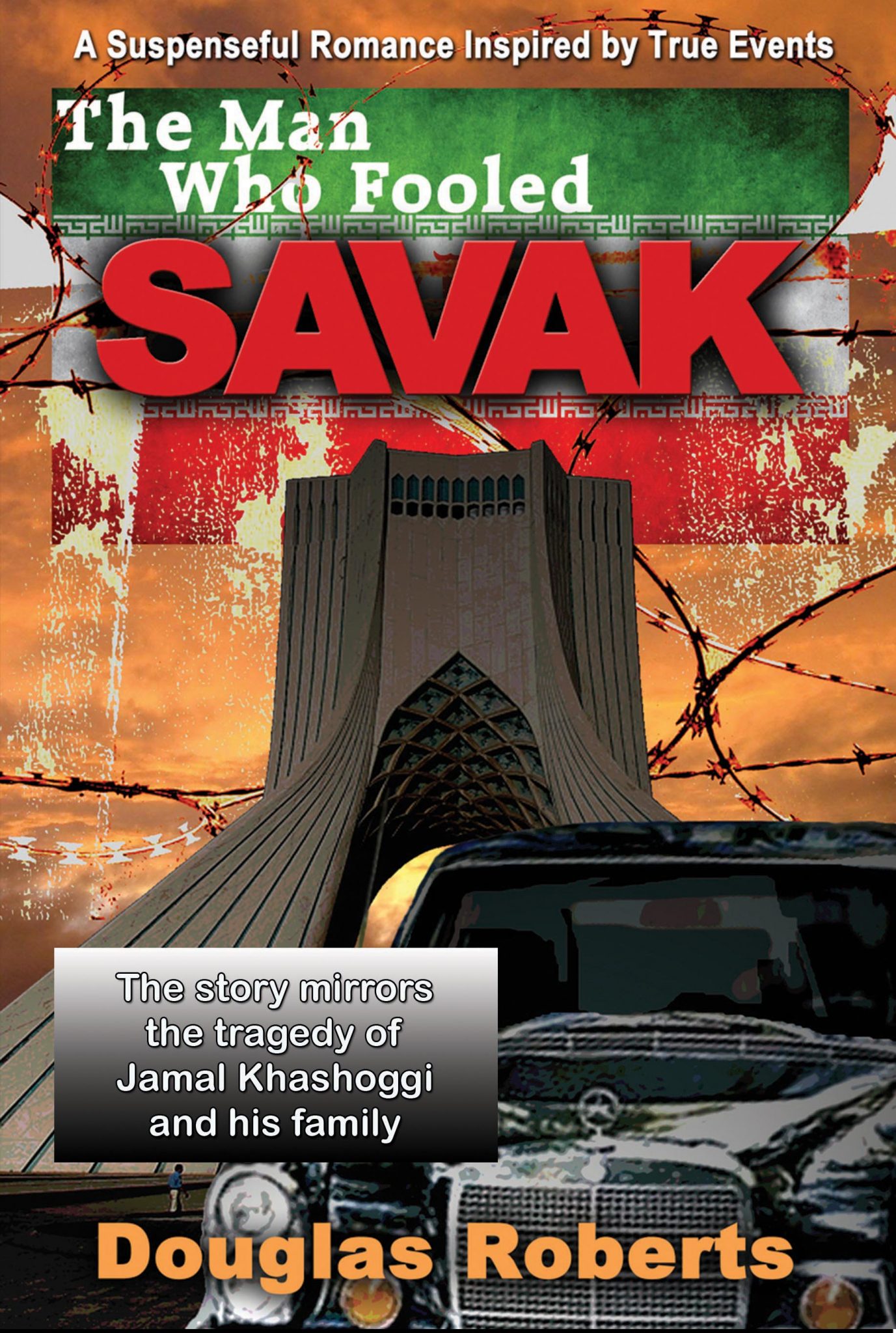
Inspired by true events in the early 1970s, The Man Who Fooled SAVAK captures what it is like to live in a dictatorship with secret police monitoring your every move – an atmosphere of fear that still pervades today in many countries in the Middle East.
Order your copy at a special publisher’s discount price of $12.99, list is $15.99.
Just click on our Bookstore tab and then click on Fiction.
We decided to reprint this interview with Douglas Roberts about what inspired him to write such a book. The interview was originally published June 19, 2011.
_______________________________________
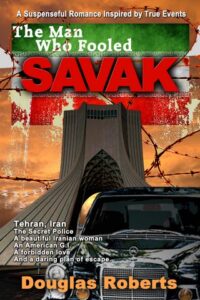 When Doug Roberts approached us with his manuscript, The Man Who Fooled SAVAK, it was one of those stories that completely engrossed you where you couldn’t put it down until it was finished.
When Doug Roberts approached us with his manuscript, The Man Who Fooled SAVAK, it was one of those stories that completely engrossed you where you couldn’t put it down until it was finished.
Inspired by true events in the early 1970s, The Man Who Fooled SAVAK captures what it is like to live in a dictatorship with secret police monitoring your every move – an atmosphere of fear that still pervades today in many countries in the Middle East.
What makes Doug’s book so appealing is that what he wrote today about events 40 years ago is still going on today in many parts of the Middle East. And all of these events are carefully woven into a love story that will make you fall in love all over again.
Q. The release of your book coincides rather well with Arab Spring. When did you start writing it?
A. In the summer of 2008. A woman I’d met on line named Erica Murray was interested in Iran so I started writing to her about it. I started doing some very preliminary research into the history and politics of Iran in 1971 in order to refresh my memory of things I had experienced when I was in Iran during that time. The book was completely finished several months before the uprising in Tunisia.
Q. Even though that was 40 years ago, there are many common elements with what is happening across the Arab world.
A. Yes, especially the fear people experience when living under an autocratic regime is something I hope I have captured, and as the book proceeds, the breaking out of that fear. Perhaps it will give people hope. Just like in my book, the methods used by various dictatorial regimes to maintain control seem to be taken from a common playbook: trample a free and independent press, keep the people fooled, use an iron fist to silence dissent, eliminate fair trials, use torture to extract confessions – the list goes on and on.
Q. But when you wrote the book, you weren’t thinking about that.
A. (laughs) True! I don’t have a crystal ball and the Arab Spring was as big a surprise to me as the rest of the world.
Q. Can I ask you about one of the characters in your book? Was there really a Junior?
A. Yes there was. I think Junior made the story possible to write. We really did sell our liquor and cigarette rations to him. I recently learned from a fellow who served in ARMISH/MAAG just before I arrived that Junior mostly dealt with the domestic workers, the Iranian nationals who worked at the bachelor quarters where we lived.
Q. I’d like to ask you about another character, Mihan Jazani. She is a historical figure, the wife of the Bijan Jazani who founded one of Iran’s guerilla movements. It appears that she’s a friend of yours on Facebook.
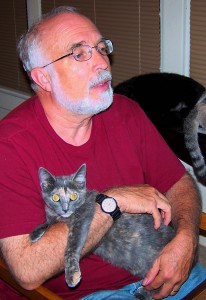 A. (Blushes) Um, well yes…so it would appear. (laughs) Actually, Mihan Jazani doesn’t like Facebook and never uses it. The Facebook account was set up for Mihan by her granddaughter, Aida. Aida and I exchange messages occasionally.
A. (Blushes) Um, well yes…so it would appear. (laughs) Actually, Mihan Jazani doesn’t like Facebook and never uses it. The Facebook account was set up for Mihan by her granddaughter, Aida. Aida and I exchange messages occasionally.
Q. How were you able to remember so much about what happened then? It was 40 years ago after all.
A. I was assisted in several ways. I had some writings I had done about Iran when I was in journalism school at Kent State in 1972. I had a large number of slides that I’d taken when I was there. Those were crucial in reviving old memories. A huge help was finding a 1977 map of Tehran on the (now defunct) Tehran American School website. I was able to use the exact names of places, even street names. The fellow I’d mentioned earlier who told me about Junior had sent me a copy of the ARMISH/MAAG directory, which was very useful. Finally, talking to people I worked with at that time was extremely important, namely Heidi Eftekhar and Barry Silver, who are characters in the story. I obviously couldn’t remember all events specifically, but I found I could generate them as needed by being very specific in my language. I would take seeds of ideas and extrapolate and grow them into full blown events. For example, a certain lecherous officer really did say to Heidi, “I think you’re a woman who needs a lot of loving.” I took that and ran with it. Last, but also important, the Internet was a valuable tool in researching the historical incidents in the book.
Q. So, where does the novel part come in?
A. Some of the human rights related events are novelized, but they’re very accurate in their portrayal of the times. I’ll leave historians to figure all that out. They will have their work cut out for them because I’ve spent a lot of effort weaving the story line into the history of those days.
Q. How close is your character Doug Roberts to the way you actually are?
A. That’s a really good question. (laughs) I had originally intended that Doug the character would be an extreme version of myself. But after having read my book now over and over, I’ve come to see that what’s extreme are the circumstances he’s in. Doug the character is a lot like I was back then: ok in the smarts department, and a little too cocky sometimes. He’s not very romantic or knowledgeable about women, but does all right in spite of himself. (laughs) There’s an element of male fantasy in the book I suppose. In the story, I have two charming female lunch companions in addition to Fari my Iranian girlfriend/fiancée.
Q. But you really were friends with Heidi Eftekhar your co-worker in the story.
A. I still am. Heidi and I communicate regularly by email and her input on the book was immensely helpful. Miss Farou is the fantasy. She actually didn’t like me all that much. (laughs).
Q. I get the impression you had a lot of fun writing your book.
A. It was pretty trippy for me at times. I would totally submerse myself in it. For example, I had written the scene describing how I spent New Year’s Eve in Iran just a couple of weeks after New Year’s Eve in real life. When someone asked me about how I’d spent my New Years, it shocked me as to how much effort I had to put into pulling up what I’d actually done versus what I’d just written. That was a little scary.
Q. What do you think people will get out of your book?
A. I’m sure everyone will get a little something different, but what I’d like for people to take from it is that, like in the story, life may present you with some extreme circumstances. When that happens, keep a level head and your wits about you. Try to see beyond what appears to be happening on the surface. There will always be some good things happening at any given moment. Try to focus on that. To get through your ordeal it’s a good idea to engage all your friends to help you and your faith if you have that. Most important of all: never give up.
The Man Who Fooled SAVAK is available as an ebook on Amazon Kindle and in various ereader formats from Smashwords.com
Outer Banks Publishing Group
ISBN-13: 978-0982993125
ISBN-10: 0982993129
BISAC: Fiction / Espionage
Outer Banks Publishing Group author Mary L. Tabor was interviewed by Shelf Unbound, the literary magazine for small press and independent books.
This is probably the most enlightening interview I have ever read on why writer’s write. A must read on Page 12.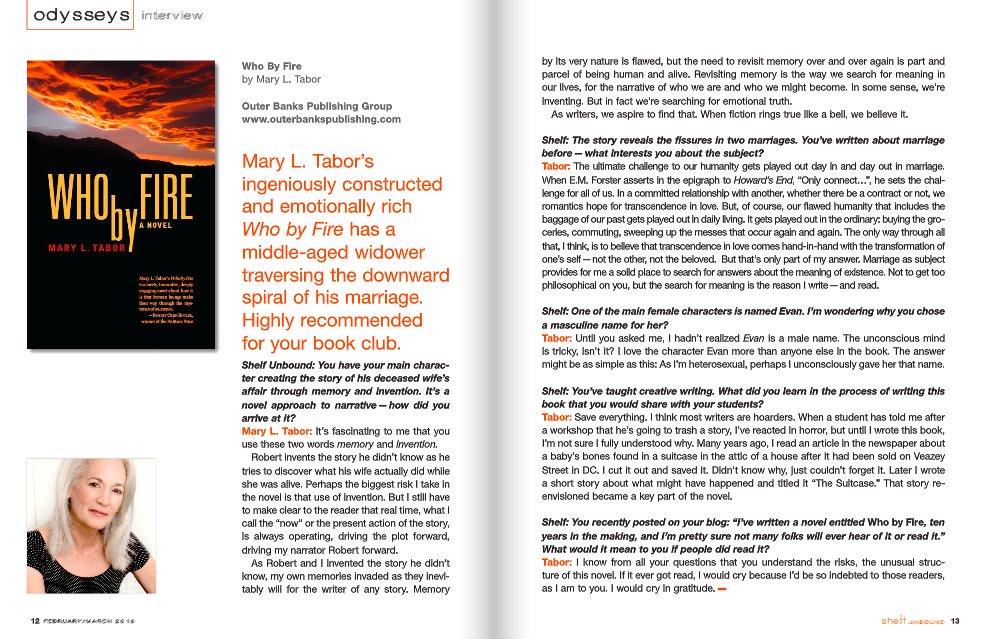
Here is an excerpt from the interview – Mary explains how the main character, Robert narrates and invents the story as it is told.
“As Robert and I invented the story he didn’t know, my own memories invaded as they inevitably will for the writer of any story. Memory is by its very nature is flawed, but the need to revisit memory over and over again is part and parcel of being human and alive. Revisiting memory is the way we search for meaning in our lives, for the narrative of who we are and who we might become. In some sense, we’re inventing. But in fact we’re searching for emotional truth.”
You can find Who by Fire on Amazon in print or as an ebook and in bookstores and retailers everywhere.
It was the worst two-week killing spree in Ohio’s history. On the night of July 21, 1948, Robert Daniels and John West entered John and Nolena Niebel’s house in Mansfield, Ohio with loaded guns. They forced the family including the Niebel’s 21-year-old daughter, Phyllis, into their car and drove them to a cornfield just off Fleming Falls Road in Mansfield. The two men instructed the Niebels to remove all of their clothing, and then Robert Daniels shot each of them in the head.
Scott Fields of Mansfield, Ohio was so intrigued by this true story that he turned the horrific events into a page-burning novel that you cannot put down until you turn the last page. During a recent book signing in his hometown of Mansfield, Scott was approached by a man he had never seen before. The man introduced himself and Scott’s jaw dropped.
By Scott Fields
Author of The Mansfield Killings
I had just begun a book signing when a dignified, older man walked through the door. He stood in the back of the room as I finished with the person in front of me. He then approached me and shook my hand introducing himself as Roger Winger. I had no clue as to who he was in spite of his obvious pause as he waited for me to take heed of his presence.
“You don’t know who I am, do you?” he asked.
“No, I don’t,” I said. “Sorry.”
“In July of 1948, I saw the dead bodies of the Neibel family lying in a cornfield off of Flemming Falls Road.”
For several seconds I stood there with mouth open trying to comprehend what he had just told me. “What did you just say?”
“I actually saw the dead bodies.”
I grabbed him by the arm and led him into another room. “How could you have seen such a thing?”
“I was six years old at the time. I lived next to the cornfield where the Niebels were found. That day was like any other summer day. I had seen the group of boy scouts marching down Flemming Falls Road earlier in the day. I hardly gave notice because boy scouts on that road was a common sight to see. Later that day, I stepped outside my house to see find police cars, ambulances and even fire engines all up and down the road. Out of curiosity, I walked down to the cornfield. There were men rushing back and forth but seemed to be concentrating on a spot about 50 feet into the field. I cautiously walked through the corn stalks until I was within a foot or so from the spot where the three people had been shot.”
“Did you see the bodies?” I asked.
“Yes, I did. Their bodies had turned white and were extremely bloated.”
“Was there signs of blood?”
“No. I don’t remember seeing any blood.”
“That’s a bit surprising,” I said. “Considering th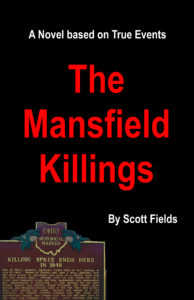 at they were shot in the head. What happened next?”
at they were shot in the head. What happened next?”
“One of the policemen saw me and yelled at me to get the hell out of here. I took off running thinking they were chasing me.”
“Daniels declared that they did not rape twenty year old Phyllis, and yet the bodies were found completely nude. The first coroner stated that there was no evidence of rape and yet the coroner at Daniel’s trial stated that she had been raped. Why do you think Daniels would admit to everything but deny raping Phyllis?”
“I’m not sure,” said Roger. “I personally think he did it. Back in those days, murder was one thing. Rape was another.”
Small talk followed, and soon we said our goodbyes. I did manage to get his phone number and address, because I have many more questions for him.
_______________________________________
The Mansfield Killings now at this special publisher’s discount price of $12.99 (List $14.99).
Publication Date: December 3, 2012
ISBN 10 – 0982993137
ISBN 13 – 978-0-9829931-3-2
Binding Type: US Trade Paper
Language: English
By MICHAEL JOHNSON
Novels about love affairs outside of marriage are a genre unto themselves and I try my best to avoid them. John Updike made a career of these stories anyway, so what’s left to say? Yet once in a while a new writer emerges with such sharp sensibilities, such descriptive powers, and such a rich story that I am forced to reconsider.
Mary L. Tabor is such a writer, and her new book, “Who By Fire” (Outer Banks, $17.95), launched a few weeks ago to a full house in a Washington, D.C. bookshop, kept me turning pages to enjoy the careful prose, the fascinating digressions and most of all the unspooling of the story.
To my mind, the story is the fire in the relationships. The ice is Ms. Tabor’s masterly control of the complex plot. The reader begins to suspect what is to come as hints are dropped along the path toward the climax. This book is hard to put down.
“Who By Fire” is a near-surgical dissection of the turmoil and pleasures that straying couples experience – and the effect on the betrayed.
Ms. Tabor takes the time to develop characters so that you care about what they are going through. She finally kills off Lena, the woman who succumbed to her lover’s charms, and she does it abruptly after setting the scene: “And then she died.”
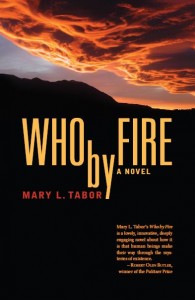 Mary Tabor is a writer who likes to say it is never too late. She started publishing her prose at age 60 and already has to her credit a frank memoir of her life and marriage entitled “(Re)Making Love: A Memoir.” Her best short stories are collected in “The Woman Who Never Cooked.”
Mary Tabor is a writer who likes to say it is never too late. She started publishing her prose at age 60 and already has to her credit a frank memoir of her life and marriage entitled “(Re)Making Love: A Memoir.” Her best short stories are collected in “The Woman Who Never Cooked.”
She takes stunning risks in her new novel, the most impressive being her decision to write from the perspective of Lena’s husband, Robert, the man who suffers as his emotions of widowhood and awareness of his dead wife’s affair mingle in his thoughts.
Jay McInerney tried the gender-swap in “The Story of My Life” but he never let you forget he was trying to sound like a girl. Ms. Tabor glides into the male perspective effortlessly and stays there.
As the narrator “Robert” reconstructs the story of his life, Ms. Tabor makes him recall what he had failed to see before his wife’s death:
“If I’d seen them on the street, I’d have known because they would have done the sorts of things that reveal: They would have passed between them a bottle of water, their hips would touch, as if by accident, when they walked; they wouldn’t touch with their hands the way safe lovers do, but an observant eye could catch both the intimacy and the caution—and know. It was when she was dying that I knew. It was the way he touched her head before he left her bedside. What I thought was an obligatory visit from a colleague changed with one gesture.”
I was propelled through this book most of all by the taut language, the dialogue and the perfect sentences, honed in the author’s years as a teacher of creative writing at George Washington University, Ohio State and University of Missouri, among others. From the outset, you are in the thrall of a confident storyteller.
Her digressions take the reader into worlds she clearly knows — the detail of the Dead Sea Scrolls, the art world, the finer points of classical music, quantum physics and the business of psychology. She has her psychologist character Evan say at one point:
“I’m beginning to think I give more comfort than cure. Not such a bad thing but not what I expected. I feel like an old broom—cleaning up, moving around the messes in people’s heads, never sure if that’s all I’m doing.”
She will throw odd words at you and expect you to understand. The apple trees are espaliered. The plants are pleached.
I was drawn into the suspense when the lovers realize that the betrayed wife is returning home early. With cinematic realism, the lovers find themselves about to be discovered when they hear the key in the lock:
“A familiar sound, merely a click, but they thought, almost as if their minds were one, that they heard the separate mechanisms of the lock moving, tumbling like thunder.”
This reader quickly turned the page to watch them awkwardly lie their way out of trouble.
Mary L. Tabor tells me she is at work on a new novel. Somehow she finds time to do a weekly internet interview about writing, broadcast on Rarebirdradio.
It is never too late, as she would be the first to tell you.
It was the worse two-week killing spree in Ohio’s history.
On the night of July 21, 1948, Robert Daniels and John West entered John and Nolena Niebel’s house with loaded guns. They forced the family including the Niebel’s 21-year-old daughter, Phyllis, into their car and drove them to a cornfield just off Fleming Falls Road in Mansfield. The two men instructed the Niebels to remove all of their clothing, and then Robert Daniels shot each of them in the head.
 The brutal murders caught national attention in the media, but the killing spree didn’t stop there. Three more innocent people would lose their lives at the hands of Daniels and West in the coming week.
The brutal murders caught national attention in the media, but the killing spree didn’t stop there. Three more innocent people would lose their lives at the hands of Daniels and West in the coming week.
Scott Fields tirelessly researched the killings, the capture and trial of Daniels and even interviewed a surviving member of the Niebel family to weave this tragic story into a must-read novel bringing the reader back to those dark days in the summer of 1948.
What led to these brutal killings, and why was the Niebel family singled-out to be savagely murdered? It has been over sixty years since the tragedy, and, yet, this question still remains unanswered. The killing spree is not only remembered to this day, but is an important and dark part of Mansfield lore.
Order your copy today at this special publisher’s discount price of $12.99 (List $14.99).
Publication Date: December 3, 2012
Discount Price: $12.99
5.5″ x 8.5″
Black & White on Cream paper
280 pages
ISBN 10 – 0982993137
ISBN 13 – 978-0-9829931-3-2
Binding Type: US Trade Paper
Language:English
 Who by Fire is told by Robert, Lena’s husband, as he attempts to understand her affair with Isaac, an affair that he has become aware of after her death. He imagines the story of his wife and her lover.
Who by Fire is told by Robert, Lena’s husband, as he attempts to understand her affair with Isaac, an affair that he has become aware of after her death. He imagines the story of his wife and her lover.
Robert the narrator is trying to know himself in the story he is writing as he tells his imagined version of his wife’s betrayal. The story becomes a paradoxical tale of his own undoing that he comes to realize by telling it.
In the epigraph to the novel, Robert says, “Life has a way of raveling. Story discovers how it happened. That is the fiction.” This is the reader’s first introduction to Robert’s persona, a man who must control the world he inhabits. The telling of the story as he imagines it, reveals more than he would have wished and as this occurs, his telling moves into real time, for there is no way for him to deal with what he discovers except to report what is actually happening versus what he has imagined.
Pre-publication praise:
Michael Johnson, foreign correspondent and writer for The International Herald Tribune, American Spectator and The Washington Times: Mary Tabor’s captivating story of love and death tackles the tangle of relationships within and outside the bonds of marriage. Her eye-popping knowledge of men’s and women’s behavior is effortlessly recounted as couples face their anguished choices. Set in a world of art, music, anthropology and science, her novel enlightens the mind while it stirs the emotions. She does all this in a confident style of prose that ranks her alongside the finest novelists working today.
Paperback: 248 pages
ISBN: 978-0-988299-314-9
Language: English
Product Dimensions: 5.5 x 8.5 inches
Publication Date: November 2012
LONDON (AFP) Thursday, September 27, 2012 10:07:54 PM
 A member of staff fills a display with copies of ‘The Casual Vacancy’, the new novel by British author J K Rowling, in a bookshop in London on September 27, 2012, as it goes on sale for the first time.
A member of staff fills a display with copies of ‘The Casual Vacancy’, the new novel by British author J K Rowling, in a bookshop in London on September 27, 2012, as it goes on sale for the first time.Harry Potter author JK Rowling spent the day “trying to avoid newspapers” as her first novel for grown-ups hit the bookshops, but she is confident the book is “the best I can do”, she told fans.
“The book is what I wanted it to be,” she told about 900 fans at London’s Southbank Centre on Thursday night after “The Casual Vacancy”, a black comedy of village life, was published — having already sold one million advance copies.
Kept closely under wraps until publication day, the book is a gritty tale involving sex and drug addiction that is widely expected to be Britain’s best-selling fiction title this year. It is already topping the Amazon charts.
Set in the fictional village of Pagford in southwest England, it tells the story of the fight to fill a slot on the parish council after the incumbent’s sudden death, and hinges on the fate of a squalid housing estate.
It took Rowling, 47, five years to complete and required another half-written children’s novel to be put on the back burner, she told her audience.
But writing it was “a lovely place to be — there was so much pressure for the Potter books”.

File photo of Harry Potter author J.K Rowling, who spent the day her first novel for grown-ups hit the bookshops “trying to avoid newspapers”. Kept closely under wraps until publication day, the book is a gritty tale involving sex and drug addiction that is widely expected to be Britain’s best-selling fiction title this year.
“I kept telling myself ‘you don’t have to publish this,'” Rowling said.
She spent Thursday watching “Men in Black 3” with her children in an effort to avoid reviews, she said — and the book has met with a mixed reception from critics.
Several found it dull in parts despite scenes of sex and drugs, and that Rowling’s most vivid writing was on the familiar ground of children pitted against the power of adults.
Famously tough critic Michiko Kakutani wrote in the New York Times that “there is no magic in this book — in terms of wizarding or in terms of narrative sorcery.
“Instead, this novel for adults is filled with a variety of people like Harry’s aunt and uncle, Petunia and Vernon Dursley: self-absorbed, small-minded, snobbish and judgmental folks, whose stories neither engage nor transport us.”
But in Britain, Allison Pearson wrote in the Daily Telegraph that “The Casual Vacancy” was “sometimes funny, often startlingly well observed, and full of cruelty and despair”.
And Boyd Tonkin in the Independent called it a “song of freedom” as Rowling was able to abandon the constraints of children’s writing following her seven books about the boy wizard.
Rowling revealed Thursday that her favourite characters in her own books were Fats — a foul-mouthed schoolboy in the new novel — and Dumbledore, the bearded wizard, wise but troubled, who is headmaster of Hogwarts in the Harry books.
She said that she would change “quite a few things” about the Potter novels, and that the actors who played Harry and his magical friends Ron and Hermione in the blockbuster films were “all too good-looking”.
Rowling has previously said she left “the door ajar” for a return to the world of Harry Potter, although she said she was not intending to write any more books about the young wizard.
Asked about the constant spectre of death in the new novel, Rowling described herself as “death obsessed”.
“Why does it obsess me? I don’t know. The easy answer is my mother died when I was 25 — she was only 45. That was clearly a formative experience.”
Writing about death had made her “less afraid of it”, she said, but she was still “frightened of leaving my children”.
Danielle Salvatore, 19, a student from North Carolina, had paid £200 ($325, 250 euros) for a resold ticket to the event.
“It’s worth it because JK Rowling inspired a lifetime of magic for me,” she said.
Rowling told fans she “hated” the intense secrecy which has surrounded each of her books before publication day, but said the risk of online leaks had forced her publisher’s hand.
In advice for budding writers, she said they should “get an agent!” and not always expect to feel inspired.
“Inspiration is clearly necessary, but then comes the long and hard work of writing,” she said. “I definitely don’t wake up and ask myself, ‘Am I inspired today?'”

If you vote for Trump and his MAGA GOP members you may indirectly start World War III.
If Trump and his MAGA GOP take control of our Congress, they will cut off support for Ukraine. They already cut support on the advice of Trump when the Congress was ready to approve the spending bill with support for Ukraine.
What will happen next?

said Larry Jacobs, director of the Center for the Study of Politics and Governance at the University of Minnesota. “This is supposed to be the party of conservative principles, of tradition, of respect for customs and rules that make society governable.
“The idea that the law does not apply to Republicans is something that has now become part of the mainstream of the Republican party. We see it in terms of the approach to elections. We see it in terms of the treatment of immigrants. Some of the actions with regard to abortion may approach that level. The Republican party appears to consider the law and the constitution to be optional and to have lost legitimacy.”
From The Guardian
Republicans’ lawless leaders at odds with midterm law and order message | Republicans | The Guardian

If you vote Republican you are supporting:
– 19 GOP red states have pending laws suppressing voter’s ability to vote. Historically, dictators and Fascists have suppressed votes to stay in power.
– The GOP has come out in support of QAnon, The Oath Keepers and the Proud Boys
– You may lose a loved one, a relative or a friend in a train crash, a bridge collapse or a plane crash as Republicans strip funds from President Biden’s infrastructure bill.
– The Texas abortion ban if left to stand will be passed in several other GOP states. Idaho will pass an anti-abortion law based on the Texas law. 16 states have “trigger” abortion ban laws.
by the US Supreme Court.
https://cnn.it/3RaW1zm
https://nyti.ms/3IcANNo
With the recent Supreme Court banning EPA authority from polluters
https://bit.ly/3IfQ1Bf
on Gun Purchases – will never get passed.
Watch Jimmy Kimmel’s emotional plea to improve gun purchase background checks
https://cnn.it/3AnRweO
– will never go up leaving 18 states still paying $7.25 an hour.
– the last thing America needs are conservative leaders, especially some Republicans who want to keep America from progressing. The last thing America needs is backward-thinking leaders in the 21st Century.
– Republicans have turned to cheating to stay in power or to get back into power…and nothing is getting done by them for the American people.
The enforcement or advocacy of strict obedience to authority at the expense of personal freedom.
and everything America stands for: Truth, Justice and Liberty for all? Look what is happening in Ukraine.
*Of course, not all Republicans are like those described above. Here is a list of those who should stay in office.
House of Representatives – those who voted to impeach the former president
Senate – The Republicans who voted to convict the former president after impeachment:
YOUR VOTE COUNTS. It’s a lie to think otherwise.
Paid for by Jake Stone for American Democracy
VOTE like your freedom depended on it…because it does.

If you have a completed manuscript, we would like to hear from you. We are currently looking for titles to publish.
Go to our Query Page (see the tab on the top) and review our submission requirements before submitting your manuscript. We like to receive the first three chapters by email.
Email to
query@outerbankspublishing.com
Copyright @ 2022 - Outer Banks Publishing Group - Designed by Webriti
